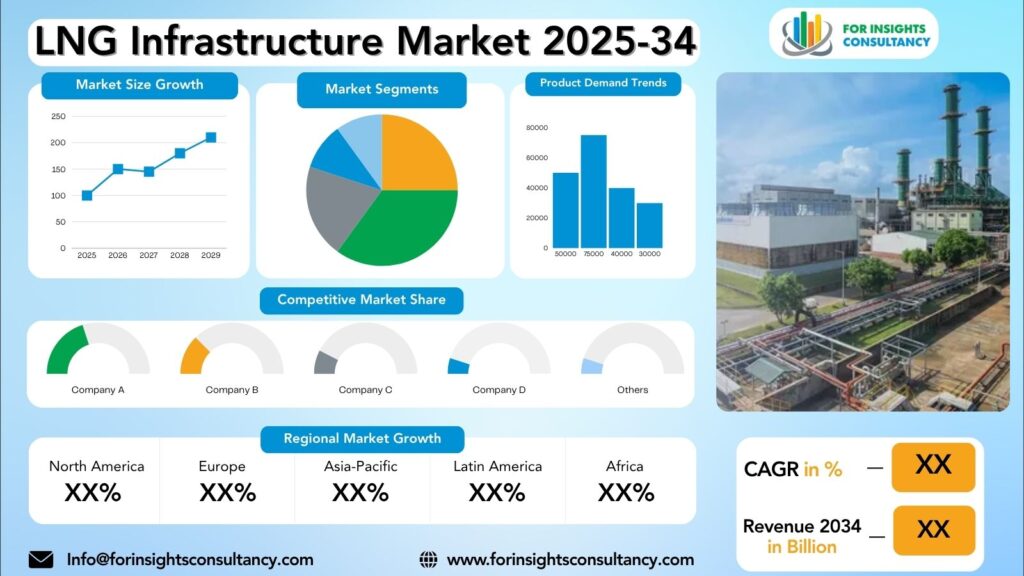
LNG Infrastructure Market Size, Trends Analysis Research Report by Type (Liquefaction Terminal, Regasification Terminal) and, by End User Industry (Heavy-Duty Vehicles, Electric Power Generation, Marine Transport), and By Region Global Market Analysis And Forecast, 2025-2034
Oct-2025 Formats | PDF | Category: Energy & Power | Delivery: 24 to 72 Hours
LNG Infrastructure Market Is Forecast to Increase from USD XX Billion In 2025 To USD XX Billion By 2034, At A CAGR Of 5.9%.
LNG Infrastructure Market: A Comprehensive Overview and Future Developments
The LNG infrastructure market is witnessing a massive expansion globally. This trend is largely driven by the growing demand for cleaner energy sources. This market is an extensive overview of the present infrastructure landscape, covering the entire chain from liquefaction plants, regasification terminals to the transportation networks. The use of LNG as a clean alternative energy source has led to a rise of infrastructural investments to cater to the demand.
Most of the future projects in the LNG infrastructure market will be about the expansion and modernization of current facilities, building new infrastructure in untapped markets, and improving the storage and transportation capabilities. In general, the future is bright for the LNG infrastructure market, as it is becoming increasingly indispensable in the global energy transition, which aims at moving towards a more sustainable and efficient future.
Market Insights
- In 2024, Asia-Pacific is projected to hold the largest share of revenue in the LNG Infrastructure Market, driven by increasing demand for natural gas in countries like China and India. The region is expected to continue its growth trajectory, benefiting from investments in infrastructure development.
- In the U.S., approximately 80% of the population is concentrated in urban areas, highlighting the need for efficient energy distribution networks like LNG infrastructure.
- Within the market segments, the liquefaction terminals segment is anticipated to capture the largest revenue share, supported by growing exports of liquefied natural gas to meet global energy demands. These factors collectively indicate a promising outlook for the LNG infrastructure market in 2024.
Market Dynamics
Trends
Market tendencies in LNG infrastructure reveal that clients require solutions that are flexible and modular, they want these solutions to support LNG usage because it is lifting the adoption of LNG as a cleaner energy source.
The market is moving towards small-scale LNG infrastructure. Such changes are due to the need for places that are far from the grid or small-scale applications such as power generation, marine fueling, and transportation.
Moreover, there is an increasing attention to the standard and sustainability of LNG infrastructure, achieved through the implementation of technologies such as digitalization, automation, and renewable energy sources. The future of the LNG infrastructure market is being impacted by these trends which facilitate innovation, cost reduction, and easing proxy for a broader use of LNG as a possible alternative to conventional fuels.
Growth Drivers
Several factors drive the growth of the LNG infrastructure market, growing demand for clean energy being one of them. The demand for LNG has increased because the white energy sources have become popular to governments and industries in their fight against emissions and their transition to more eco -friendly energy sources. Moreover, natural gas utilization is becoming more and more widespread as a dependable and cheap way of producing electricity and powering vehicles thus sparking the LNG infrastructure market. Facility extension for LNG liquefaction and regasification is one of the factors that have the potential to foster a market growth besides improvements in storage and transportation technologies. Besides, the global trade in LNG is expanding and the origination of new shipping routes is enabling the build-up of infrastructure thus paving the way for the LNG sector to become one of the most attractive for investors.
Restraints
The LNG infrastructure market has to cope with a series of restraints that can slow down the rise and the development of the market. Among those, high initial investment costs of building LNG terminals, liquefaction, and regasification facilities are considered one of the major restraints. This may be a significant obstacle to companies that wish to enter the market or extend their infrastructure. Besides that, regulatory problems and difficulties in obtaining permits may postpone the time of the project and raise the costs.
Moreover, the restriction of places available for LNG infrastructure projects is another restraint, where this is more pronounced in heavily populated or environmentally sensitive areas. In this case, getting permits and authorizations for new facilities may become a challenge. Besides, the instability of global LNG demand and prices affects the profits of infrastructure projects and instills the investors’ caution in choosing new developments for investment. To sum up, the mentioned restraints outline the difficulties confronting the LNG infrastructure market and the necessity of finding resourceful ways of getting over them.
Opportunities
The LNG infrastructure market offers attractive opportunities that are mainly driven by the growing demand for natural gas, which is considered a cleaner alternative to traditional fossil fuels. The primary factor that is leading to LNG infrastructure development is the need to reduce carbon emissions and make a transition to sustainable energy sources.
The opportunities in the market comprise the extension of LNG terminals and regasification facilities, building of LNG bunkering stations for marine vessels, and setting up of LNG transportation networks. Besides that, the progress in technology that includes the introduction of small-scale LNG solutions and floating storage and regasification units (FSRUs) is rapidly changing the landscape of the LNG infrastructure market, thus creating many new possibilities for finding market growth.
Hence, the market has great potential to offer the players to not only take advantage of the increasing demand for LNG but also play a vital role in the energy transition towards a cleaner future.
Challenges
The LNG infrastructure market has to deal with multiple issues alongside its glorious worldwide spread. Building liquefaction plants, storage tanks, and regasification facilities is one of the biggest hurdles putting the market on hold. The high upfront costs associated with these are the major obstacle to the LNG infrastructure market. On top of that, navigating complicated regulations and getting permits can become a very lengthy and expensive process for companies that are in LNG infrastructure development. New frontiers require it too, such as technology investments, to make processes more efficient and have a less negative environmental impact. Besides that, the unpredictability of LNG demand and pricing is another source of anxiety for the market that may affect the long-term viability of infrastructure projects. Addressing these issues, overall, will be a determinant factor for the continuation of the LNG infrastructure market’s environmentally-friendly development in future years.
LNG Infrastructure Market Top Companies Covered In This Report:
Evaluate The Strategic Positioning And Innovation Pipelines Of Leading Market Companies-From Multinational Enterprises To Disruptive Regional Firms. Understand How Key Players Are Innovating, Expanding, And Capturing Value, And Use Competitive Benchmarks To Plan Your Next Move.
LNG Infrastructure Market Company News 2024 and 2025
June 25, 2025 Chevron Chevron has expanded its LNG supply agreements. Notably, Energy Transfer LNG (Lake Charles LNG) and Chevron USA agreed to expand a supply agreement: an additional 1.0 million tonnes/year (tpy) of LNG, bringing Chevron’s total contracted volume from that supplier to 3.0 million tpy.
Anadarko Announces Advancement Of Mozambique LNG Project
Anadarko Petroleum Corporation announced that it has reached Heads of Agreement (HOA) with Eni, establishing foundational principles for the coordinated development of the common natural gas reservoirs spanning both Mozambique’s Offshore Area 1 (operated by Anadarko) and Offshore Area 4 (operated by Eni).
Oct 2025Eni / YPF (Argentina, Vaca Muerta project)
Progressing on gas project; expected soon to finalize investment decision. Includes production, treatment, transport, liquefaction via floating LNG units. Capacity planned ~12 million metric tons/year.
Oct 2025 Commonwealth LNG (USA)
Request for an extension (to Dec 2031) for its export facility in Louisiana, citing delays beyond its control; still aiming for a Final Investment Decision by end of year.
Oct 2025 Eni – Coral North (Mozambique)
Approved second floating LNG unit offshore Mozambique. Will double Mozambique’s LNG production to over 7 million tons annually starting ~2028.
Segmented View of The Industry:
The LNG Infrastructure Market Is Mapped Through A Multidimensional Lens-Tracking Shifts Across Product Type, Applications, And Geographic Regions. This Segmented Approach Enables Businesses to Localize Their Growth Plans And Align Offerings With The Most Profitable Demand Centres.
Segmentation By Type
- Liquefaction Terminal
- Regasification Terminal
Segmentation ByEnd User Industry
- Heavy-Duty Vehicles
- Electric Power Generation
- Marine Transport
Global Geographic Coverage:
The Report Provides In-Depth Qualitative And Quantitative Data On The LNG Infrastructure Market For All Of The Regions And Countries Listed Below:
North America
The North American LNG infrastructure market will experience a sharp rise in its volume of operations, which is expected to be equivalent to a GDP growth rate of 2.6%, while the inflation rate is expected to reach 1.9%. In this market, the United States holds significant influence, which is a result of the government’s specific subsidy that is directed solely to LNG exports. This subsidy has become the primary factor behind the great LNG infrastructure boom in the country.
The most effective means of dealing with the LNG infrastructure in North America are through the establishment of strategic partnerships with the major players in the industry, while the quickest developing channel is the sales made directly to the consumers through online platforms. Consumers are gradually giving more weight to sustainability and ethical sourcing as key factors when making purchases, particularly in emerging markets where price and status are very important in buying decisions.
In general, the LNG infrastructure market in North America is doing very well with new and innovative approaches to be implemented, and the strong focus on sustainability as a major driver for growth and consumer preference.
Europe
The LNG infrastructure market in Europe is expected to grow leading to a projected GDP of 3% per year, with an inflation rate of 1.5%. Specific for Germany is the clean energy transition government subsidy, a local driver that has a significant impact on the market. In the region, government tenders and contracts form the primary channel for LNG infrastructure, whereas the direct partnership with energy companies is the fastest-growing channel.
Consumers in the market require sustainability and ethical sourcing, which are particularly emphasized in countries like Sweden and Norway. In contrast, in developing markets, where price/status is the leading factor, for instance, in Eastern Europe, the affordability and the prestige of the brand take a significant part in the decisions consumers make.
Asia Pacific
The market for LNG facilities in the Asia Pacific region is expected to expand largely due to the stable growth of the region’s GDP and its low inflation rates. China, Japan, and South Korea are the main sub-regions that bring about this positive trend. In China, the government subsidy for LNG infrastructure development is the main driver that encourages investments. The main way for LNG infrastructure in Japan is through strategic partnerships with established energy companies, while the quickest-growing channel is direct sales to industrial consumers. Ethically sourced products and sustainability are essential for consumers in South Korea, where localism is also a major factor. In frontier markets like Indonesia and Vietnam, prices and status are still the main factors of consumer preferences, with cost-effective solutions being a key element in the penetration of the market.
Middle East and Africa
The LNG Infrastructure Market in the Middle East and Africa is a vibrant market that is being driven by the region’s GDP growth forecast and inflation rate. The Middle East and Africa sub-regions are at cross-purposes with one another in terms of the range of opportunities and challenges.
Within the region, a government subsidy on the development of LNG infrastructure that is unique to a country is the main local, non-duplicable driver of LNG technology. The subsidy is the core element that plays the role of the main incentive for companies to invest in LNG projects.
Most LNG infrastructure in this region is channeled through government partnerships and collaborations, which is the dominant channel. However, the private sector initiatives and foreign investments are the fastest-growing channel.
Consumers in this region consider sustainability and ethical sourcing as the most important factors, and as such, these factors are mandatory for products in the LNG infrastructure market. Besides, in the majority of the emerging markets in the Middle East and Africa, the price and status are still the main factors that influence consumer preferences and purchasing decisions.
Reasons To Buy:
- The Research Would Help Top Administration/Policymakers/Professionals/Product Advancements/Sales Managers And Stakeholders In This Market In The Following Ways.
- The Report Provides LNG Infrastructure Market Revenues At The Worldwide, Regional, And Country Levels With A Complete Analysis To 2034 Permitting Companies To Analyze Their Market Share And Analyze Projections, And Find New Markets To Aim For.
- To Understand The Most Affecting Driving And Restraining Forces In The Market And Their Impact On The Global Market.
- Major Changes And Assessment In Market Dynamics And Developments.
- The Objective Of The LNG Infrastructure Market Report Is To Identify New Business Opportunities Using Quantitative Market Forecasts.
- Formulate Sales And Marketing Strategies By Gaining An Understanding Of Competitors, Their Positioning, And Strengths & Weaknesses.
Faq – What Global Leaders Are Asking
How big is the LNG Infrastructure market?
LNG Infrastructure Market Is Expected To Achieve A Stable Growth Rate With A Compound Annual Growth Rate (CAGR) Of About 5.9% From 2025 Through 2034.
What are the main components of LNG infrastructure?
The LNG infrastructure market comprises several key components crucial for the liquefaction, transportation, and regasification of liquefied natural gas (LNG). These components include liquefaction plants, LNG carriers, LNG terminals (including import and export terminals), storage tanks, regasification units, and pipelines.
Who are the key players in the LNG Infrastructure market?
The LNG Infrastructure Market Includes Major Companies Cheniere, Gazprom, INPEX, Novatek, Others.
Which region holds the largest LNG Infrastructure market share or is growing the fastest?
Asia-Pacific region currently holds the largest share in the LNG infrastructure market, driven by increasing demand for LNG in countries such as China, Japan, and South Korea.
What are the primary drivers of the LNG infrastructure market?
The LNG infrastructure market is primarily driven by rising global energy demand—especially in Asia and Europe—and the shift toward cleaner fuels replacing coal and oil. Additionally, energy security concerns and long-term contracts are accelerating investment in liquefaction, regasification, and storage facilities.
What is the future outlook for LNG infrastructure Market?
The LNG infrastructure market is expected to grow steadily through 2030, driven by increased demand for flexible, low-emission energy and expanding trade routes. Emerging markets and floating LNG technologies will play a key role in accelerating infrastructure development.
What challenges face the LNG infrastructure market?
The LNG infrastructure market faces challenges such as high capital investment requirements and complex regulatory and environmental approvals. Additionally, fluctuating global gas prices and supply chain disruptions hinder project viability and expansion.
Customized Report as per your Business Needs
- Our analysts will work directly with you and understand your needs
- Get data on specified regions or segments, competitor and Vendors
- Data will be formatted and presented as per your requirements
Any Requirement Contact Us: Https://Www.Forinsightsconsultancy.Com/Contact-Us/
Table of Contents
For TOC Contact us: https://forinsightsconsultancy.com/contact-us/







